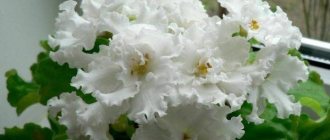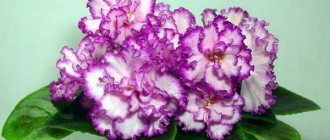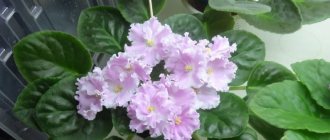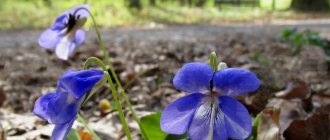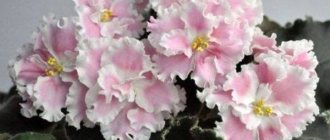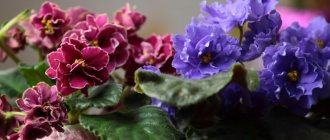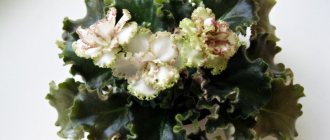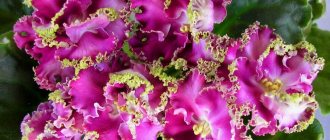Botanical description of the plant
The name of the company is derived from two words: “Optima” - the best and Usambara - the name of the mountain in Tanzania on which the first Saintpaulia was found. The company's catalog, updated annually, regularly presents about 100 different varieties.
A classification of violets according to the diameter of the leaf rosette has been proposed:
- miniature (up to 15 cm in diameter);
- semi-miniature (up to 20 cm in diameter);
- standard (up to 40 cm in diameter);
- large (more than 43 cm in diameter).
All violets do not root too deeply and have a fibrous root system.
A leaf rosette develops almost right next to the ground. As it grows, it will rise above the soil on a small stem. The leaves can be colored in any shade of green: from light to very dark. Shape of violet leaves "Optimara":
- flat;
- heart-shaped;
- oval;
- with a pointed edge.
Features of the surface and edge of the sheet plate:
- jagged edge (slightly to heavily jagged);
- wavy edge;
- hairy leaf plate;
- convex or flat sheet plate.
In nature, Saintpaulias bloom with white, five-petaled flowers that rise above the leaf cap. Pedicels can be of different lengths. The number of flowers depends on the variety and the conditions in which the plant is located. The color range is very diverse. Some modern species can boast of having several shades or unique colors on different flowers of the same Saintpaulia.
Did you know? Saintpaulias are not true violets and have a number of differences, both in their life cycle and in care. They are also called African violets, after the region in which they were first discovered. They grow well indoors all over the world, including in temperate climates.
The following types of violet flowers are distinguished:
- single-color five-petal; where the top 2 petals are slightly smaller than the rest;
- in the shape of a “star” - with 5 or 6 petals of equal size;
- semi-double - they have more than 5 petals and yellow, clearly visible anthers;
- double - 10 or more petals that form a flower resembling a rose;
- tubular - very rare, similar to a bell.
The shape of the edge of the petal is:
- in the form of a small wave;
- flat;
- in the form of a fringe.
According to the type of color, Saintpaulia "Optimara" flowers can be:
- single color;
- two-color;
- multicolor;
- fantasy (with lines, spots, broaches).
The flowering period lasts from September to March. If the conditions of detention are not optimal, then it takes only a few weeks. In good conditions, flowering can last several months. Saintpaulia flowers form small seed pods. Thanks to this, the plant can reproduce both by seeds and leaves. Violets are easily pollinated, so breeders have received and continue to receive new varieties today. The selection is based on the decorative qualities of the plant.
Optimara violet: types and varieties with photos
Violet Optimara: photo of the variety
Optimara violet has a large number of varieties; below are several types of this variety:
- Optimara My Love is a plant with olive-colored leaves with brown veins. The buds are cream-colored, with a dark purple color in the center. The appearance changes: in winter it is white, with a lilac center; in summer, the plant is completely covered in purple, with a white outline around the edges. The rosette is in good condition, small, straight stems, regular flowering.
- Little Moonstone is a flower with large white buds with a bluish center. The leaves grow downward, olive in color, ribbed along the edges. The branches are tall and thin. The highlight of the plant is that in cold weather the white inflorescences become greenish in color. The stems are tall, but very strong, as they support a large number of flowers that bloom regularly. The flowers open for a long time, the small inflorescences have a velvety feel. The plant takes a long time to ripen, it can be up to thirty days.
- My Dream is a soft and fragile type of plant, cream-colored inflorescences, purple center, their size can be up to seven centimeters. The stems are small in size, holding from two to four inflorescences, the inflorescence is long-lasting. The leaves are simple and green. On the other hand, they may be brown in color. The rosette is good and strong.
- Chagall – the buds of this plant are velvety, dark purple in color, with a white center. The foliage is medium-sized, neat, looking down, green in color, brown on the other side. Looks like Pansy flowers.
- Millennia is a beautiful plant, its buds have a double shade, the petals can be white, and their center is fuchsia. The highlight is the velvet edges. Large inflorescences ripen with a large number of flowers. The rosette is neat, the leaves develop in the form of a trapezoid. The color of the leaves is bright green, on the other hand the color is brown, the size is medium, the plant looks aesthetically pleasing in appearance.
- Ever Grace is a flower with many colors in one plant. One flower can have up to three different colors, it can be dark sea, as well as snow-white, with an olive rim, this is different from all other types. The leaves are green, velvety, and heart-shaped.
- Ever Precious - the petals of the buds of this plant are velvety snow-white, the edges are lilac, can be purple, or light green. The leaves are smooth, ordinary, with villi, curling.
- My Desire - the flower has snow-white buds, the middle color is fuchsia. The leaves are green, heart-shaped, with ribbed edges. The rosette is compact and ordinary.
- My Passion - snow-white buds, purple cent, similar to stars, large size, from five centimeters. The rosette is compact, the foliage is large, similar to burdock. The stems are strong.
- Little Crystal is a plant with white fuzzy buds. The leaves are pastel green, heart-shaped, neat. The branches are fragile, olive-colored on one side and silver on the reverse. The inflorescence is large, beautiful, the stems are tall, in large quantities.
- Nebraska - with ordinary, fleecy lilac inflorescences, with a snow-white outline along the edges, this gives even greater beauty to the plant. Leaves are emerald green and glossy. The inflorescence takes a long time to mature.
- Annabelle is a plant with charming dark purple buds that look like a bell. Medium in size. The charm is in the contrast of colors. The leaves are emerald, fleecy, heart-shaped.
- Rita – the buds of this plant are white, the leaves are purple. The edge of the plant is wavy. The foliage is green, rounded, with a compact rosette.
- Dali is a plant with fuchsia-colored buds, a white cent. The foliage is olive in color, with a neat rosette.
- My Joy - snow-white buds, bluish center. The stems are powerful. The foliage is green in color, fleecy, medium in size. The rosette is compact.
- Kansas is a plant with snow-white buds, a fuchsia center, with fuzzy edges, similar to stars. The leaves are ordinary, glossy, fleecy, green, brown on the underside.
- Little Emerald - a flower with snow-white fuzzy buds, similar to stars, a fuchsia center. The leaves are oval, light green, ribbed. The rosette is compact. The plant is small.
- Michelangelo is a plant with snow-white buds, the center of which is purple in color. The leaves are green, fleecy, flat, the edges are elongated and ribbed.
- Hiroshige is an ordinary plant, the buds are snow-white, the center is bluish. The leaves are green, fleecy, heart-shaped, the rosette is flattened.
- My Charm is an ordinary plant, white buds, purple in the middle. The inflorescence is abundant, the stems are strong. The leaves are ordinary, green, oval.
- Trinidad - fleecy buds of snow-white color, brighter along the edges. They may be darker on the upper or lower petals. Leaves are emerald green, elongated. The rosette is compact.
- Little Inca – the buds are the usual bright bluish color. The inflorescence is long. The leaves are light green, charcoal, smooth, fleecy, also with chopped edges.
- Little Ottawa is a plant with a large number of fuzzy fuchsia inflorescences. The foliage is fleecy, small, emerald in color, the underside is brown, oval in shape, the edges are ribbed. The inflorescence is large. Depends on the temperature in the room, if it is cold, the plant acquires greenish edges on the flowers. It takes a long time to ripen, the opening of flowers also takes a long time, such beauty disappears in a period of one to two months.
- Little Oneida is a plant with large snow-white buds, a fuchsia center. The size reaches up to five centimeters. The rosette is compact, the leaves are light green and wavy. Grows quickly and flowers as well.
- Ever Glory is a plant with fuchsia-colored buds, light green edging. The rosette is compact, grows in the form of a bouquet, for a long time. The leaves are green.
- Monet - charming flowers with snow-white buds, with a purple edge. The leaves are green, fleecy, elongated, ribbed. The rosette is neat. The inflorescence is fast.
- Michigan is a plant with cream-colored buds. The leaves are green, fleecy, brown on the underside. The rosette is neat, the inflorescence is regular and large.
- Isabelle is a plant with creamy pinkish buds. The leaves are emerald, fleecy, pointed. The rosette is medium, the inflorescence is regular.
Above were presented the most famous types of plants that can be purchased in the store. A large number of varieties gives a chance to choose exactly what a person needs. Once the decision is made, it is necessary to learn about the cultivation.
Varieties: list with brief description
Today “Optimara” includes more than 15 series of standard violets and the “Mini” series, within which there are subseries. Optimara brings more than 1,000 varieties to the market, many of which were developed in the 1950s–1980s. Every year the variety base is replenished with new specimens.
Did you know? The famous French emperor Napoleon Bonaparte declared violets to be his flower and often put a violet flower instead of a signature.
Main series of standard and semi-miniature varieties:
- "US States";
- "Iceland Series";
- "Indian Summer";
- "Southern Beauty";
- "Victorian charm";
- "World Travel";
- "My Violets";
- "Canadian provinces";
- "National Park";
- "Rhapsody" and others.
The most prominent representatives of the “US States” are:
- "Alaska" — its matte white flowers with a blue border resemble northern ice on a cloudy day;
- "Arkansas" — these incredibly bright red flowers will attract attention in any interior, because there are at least 20 flowers in the header;
- "Colorado" - an amazing combination of dark purple flowers and bright green leaves;
- pink flowers "Louisiana" they look as if they were tanned by the sun and none of them are like the other;
- thin white fringed border on purple flowers of the variety "Hawaii" immediately reminds of the fiery dances of the south;
- unique shade of ultramarine "Texas" complemented by an almost cowboy carved border.
The Icelandic series is represented by two-color violets, where the main color is complemented by a small border along the edge of the flower:
- purple-white "Barbados";
- red and white "Jamaica";
- bluish-white "Dominica";
- bright pink and white flowers "Puerto Rico".
The very large violets in the World Travels series are named after major cities.
You will definitely love the hot pink stars of “Paris” or the double blue and burgundy flowers of “Los Angeles”. The series “My Violets” (myViolet) was presented to the general public in 2009. It combines beautiful flowers with a bright inner part of the flower and a white outer edge. Each flower seems to be divided into 2 different parts.
- "My love" — owner of a fuchsia core;
- "My charm" - these are flowers in ultramarine shades;
- "My desire" They present deep pink flowers among a rosette of dark green leaves.
One of the oldest is the Rhapsody series. It was presented at the exhibition in 1956 and includes more than a hundred varieties.
All violets in this series are named after women:
- "Juliana" - the owner of two-color purple-white flowers and heart-shaped leaves;
- "Ingrid" presented in 2 variants, an older variety with solid pink flowers and its updated dark blue variation;
- "Irene" - its oval dark green leaves are decorated with a cap of two-color white flowers with a purple edge;
- "Rita" - two-color beauty: pink inner part of the flower and white outer part, complemented by a ribbed border.
In 1984, a unique series of space violets was created. Its backbone consisted of seeds that were in low-Earth orbit along with the American Shuttles. The goal of the program was to study the effect of cosmic radiation on seeds. The resulting flowers became the beginning of the new “EverFloris” series, and today there are 11 different varieties.
Among them:
- purple "EverLove";
- soft pink "EverGlory";
- white with blue tint "Ever Praise".
But you may not pay attention to the color of the variety in the picture. Cosmic radiation not only made the flowers much larger, but also affected their shades: in two pots you will get 2 Saintpaulias with different color intensities.
The series of miniature violets is represented by 30 varieties. They are designed to be grown in miniature pots, about 3–6 cm high. Miniature violets bloom much longer than regular violets. They are also distinguished by the fact that during flowering their flowers almost cover the leaf rosette. The Mini series is divided into several subgroups. "Little Gems" are super mini violets for 1" pots. "Little Indians" are also minis, but larger in size for 2-inch pots.
The main representatives of the “Little Jewels” series:
- "Little Amethyst" - this is a plant with semi-double flowers of purple-red color with a white border;
- "Little Apatite" - a small violet with purple flowers;
- "Little Azurite" - owner of blue flowers with a white border;
- "Little Coral" is a miniature violet with double pink flowers and medium green leaves.
The main representatives of the “Little Indians” series:
- "Little Apache Girl" - a variety with double pink flowers and terry convex leaves of moderate green color;
- "Little Aztec Girl" - violet with red flowers, sometimes with a white center and oval dark green leaves;
- "Little Comanche Girl" - a variety with purple flowers, convex shiny leaves;
- "Little Greek" - violet with incredibly delicate pink flowers of a darker shade in the center of the flower.
New to the 2022 catalog is the “Little Trio” with lilac-white-green flowers. The uniqueness of the variety is that the color of each flower is unique. You will not find 2 identical ones in one plant.
Optimara violet: variety description and characteristics
Violet Optimara: photo of the variety
In most cases, you can find violets whose names do not at all match their original name. For example, violets that are grown on windowsills are called Saintpaulia. This flower is attractive, its color is unusual, it is part of the Gesneriev genus. The well-known version of violet is Uzambara, it can be purchased at any gardening store, as well as in supermarkets; it is ideal for home use, even for beginners.
The Optimara violet has been known since one thousand eight hundred and ninety-two; its home is the eastern territory of Africa, growing in coastal places, next to waters in moist soil. Its discoverer was Baron Walter von San-Paul, he collected the seeds and brought them to Germany. Thus, the violet was named sanpolia in honor of this baron. Since one thousand eight hundred and ninety-three, the plant fully participated in fairs and exhibitions in Germany, then it became known throughout the world.
The variety of this flower is off the charts, there are more than thirty-two thousand varieties, a couple of them belong to domestic gardening. The plant is constantly green in color and lives for a large number of years. In appearance it has a small stem, the leaves grow from the roots. The color of the leaves can be dense green, and they can also be spotted. The leaves seem to be terry, even, rounded, in the shape of a heart. The buds consist of five petals connected to each other. The box contains two stamens, one pistil, an ovary at the top, and two carpels.
The seeds of the Optimara violet variety sit in a box; in appearance they are small oval seeds, elongated on one side. The plant can be propagated using leaves cut from the parent bush, then they are left to settle in water, then planted in the soil. It is recommended to use special soil; it can be purchased at a gardening store, or you can make it yourself, adding pine needles, turf, leaves, and peat to its composition.
For the rapid development of the plant, it needs to be weeded, hilled, and you also need to add: perlite, vermiculite, sand from the coast of reservoirs, sphagnum. You should also regularly moisten the soil and ensure that there is no drought. Also make sure that there is no stagnation of water in the soil, otherwise the plant will begin to rot and eventually die.
For the comfort of the Optimara violet, you should regulate: temperature, air humidity, lighting. If all these points are fulfilled, then the plant will respond in kind, show all its beauty, and will delight the grower for a sufficient time.
Conditions for successful growing at home
The violet should be placed indoors in such a way as to provide optimal conditions for growth:
- light - moderate, possibly bright, but always indirect;
- watering - the soil must be slightly moist, but if it is dry near the roots, this will stimulate flowering;
- air - violet does not tolerate drafts and sudden changes in cold air.
Important! To check if the lighting is correct, place your hand over the violet on a sunny day. If there is no shadow from the hand
—
This is the right lighting.
Location and lighting
Of all the varieties, the most popular are those that tolerate low light levels well. But in most varieties the leaves begin to turn yellow. Therefore, the violet must be placed in such a way as to provide it with bright, but indirect lighting. This can be a west or east window. On southern windows, violets are shaded from the sun with curtains or blinds. The correct luminosity for Saintpaulias is between 10,000 and 12,000 lux.
The intensity of sunlight varies depending on the time of year. In winter, violets can be rearranged to receive more light. Rotate the flower ¼ turn each time you drain the tray to ensure even leaf development. If you do not turn the violet, the leaf rosette will begin to lean towards the light source.
If an artificial light source is installed, make sure the plant receives enough light in the red and blue spectrum. Blue is needed for photosynthesis, and red is needed to support flowering. Set a distance of at least 0.5 m between the plant and the light source. Violets need an 8-hour period of darkness per day to begin flowering. This is enough to activate the flowering hormone.
Air temperature and humidity
Saintpaulia thrives in the same conditions that most people enjoy in terms of temperature, humidity and air composition. If you're comfortable, chances are your violets will be too. The temperature should approach +21°C. Do not allow it to fall below +15°C or rise above +27°C. A slight difference between day and night temperatures does not harm the plant. It is normal for these parameters to fluctuate within 10 degrees. At constant high temperatures, violets' stems and leaves lengthen. Then the leaves begin to dry out and fall off.
Did you know? The petals and stems of violets contain large amounts of vitamin C, which they contain even more than some vegetables.
At temperatures below +15°C, plant growth slows down and the violet may die. A sign of death is hanging limp leaves. Optimal humidity is from 70 to 80%. But since in most apartments the humidity is not higher than 60%, it can be increased by using a tray with wet pebbles. As moisture evaporates, the humidity around the flower will increase. Low humidity prevents flower buds from opening. There should be enough space around each plant to ensure good air circulation. This also prevents the transfer of fungal spores if one of the plants becomes diseased.
Optimara Nebraska
236 RUR
Buyer protection Found cheaper?
JV
10 Quick purchase with delivery time up to 10 days in Vladivostok. In such purchases, you do not need to wait for the order to be confirmed. You place an order and pay for it immediately.
Delivery not available
Reviews (792) Purchase rules
Article: F273
Organizer: LenVas 21.5
The product is out of stock
Single to semi-double red-purple flowers with a wide white contrasting ruffled border. Dark green simple shiny leaves. Abundant, absolutely luxurious flowering.
Ask a Question
Find reviews
Question to the organizer
Ask a Question
Popular Purchase Products
RUB 354
- Size
- Freshly cut leaf×
- Go to cart
Begonia Madame Pompadour
Beautifully shaped rounded leaves with a pointed end and a spiral center. The center and edge of the leaf are dark...
236 RUR
- Size
- Freshly cut leaf×
- Go to cart
Begonia Vanessa
Beautiful silvery soft green leaves curling into a shell. In good light, a rose leaf...
118 RUR
- Size
- Freshly cut leaf×
- Go to cart
Begonia Rohceart
A lush, well bushing plant with round, quilted, spirally twisted leaves at the base...
RUR 177
- Size
- Freshly cut leaf×
- Go to cart
Begonia Fedor
Begonia from the Dutch Magic Colors series. Silvery green leaves with dark...
295 RUR
- Size
- Freshly cut leaf×
- Go to cart
Begonia helen teupel
Interesting elongated serrated leaf shape. The leaf color is dark with bright pink prints of different...
RUR 251
- Size
- Freshly cut leaf×
- Go to cart
Begonia Black Beauty
A beautiful green leaf bordered by a wide dark green stripe along the edge of the leaf. Shell leaf shape...
148 RUR
- Size
- Freshly cut leaf×
- Go to cart
Begonia DS-Pearl
Compact variety, perfectly forms a bush. The leaves are textured, shiny, and pearly in color. The shadows are gentle...
RUR 222
- Size
- Freshly cut leaf×
- Go to cart
Begonia DS-Swan
Very light leaves, light milky white with a light pink wide border and pink in the center of the leaf...
RUR 222
- Size
- Freshly cut leaf×
- Go to cart
Begonia DS – Bird talker
Pointed, with carved edges, very light leaves are covered with pink specks along the veins, wide…
RUR 177
- Size
- Freshly cut leaf×
- Go to cart
Begonia Evening Glow
Medium height, fast growing and bushes well. The silvery color of the foliage makes it an indispensable com...
RUB 354
- Size
- Baby×
- Go to cart
Begonia Mason
Very memorable large bright green leaves with a brown cross in the center. Large juicy...
236 RUR
- Size
- baby×
- Go to cart
Optimara Ever Love
Simple purplish red pansies with a wide pink and white border and a green fringed edge. Dark...
Home care
In addition to maintaining an optimal microclimate, Saintpaulia needs to be regularly watered and fertilized, and also monitored for pests. For dense leaf rosettes, periodic thinning is carried out to make room for flowers to appear.
Watering
The frequency of watering depends on the condition of the soil. If the top layer is dry to the touch, then it’s time to water. Saintpaulia should be allowed to dry out completely periodically for best flowering results. Overwatering is detrimental to it. If the roots don't dry out, they can't get the air they also need. Violets are prone to deadly pathogens such as root rot, crown rot and pythium root rot. Excess moisture limits the access of nitrogen to the roots, which becomes the root cause of rot.
The water should be at room temperature, or as close as possible to the air temperature at the time of watering. Too cold, it chills the roots, causing the leaves to curl. It will be nice if watering is carried out using drip irrigation. To do this, pour water into the tray with the flower and leave it for a while. The soil will absorb exactly as much water as the roots need. Remove water from the pan after 30 or 40 minutes.
Important! Never use soft water. It increases the salt content of the soil and changes its acidity, reducing the ability of Saintpaulia to absorb nutrients.
Top dressing
Saintpaulias need special violet fertilizers with a higher dose of phosphorus. It should be 2 times more than other components. You can apply fertilizer immediately after each watering in an amount of ¼ of the usual rate. If the leaves turn pale, then the violet does not have enough nutrients. When choosing fertilizers, make sure they are 100% water soluble. This is important, since violet consumes nutrients only from an aqueous solution.
The role of the main substances in the development of Saintpaulia:
- nitrogen is important for the growth and development of leaves and stems;
- phosphorus helps the growth of healthy roots and plays a vital role in promoting flowering;
- Potassium is necessary for the accumulation and movement of compounds that provide energy to the plant.
Learn about the features of planting and growing violets at home.
Trimming
Pruning is necessary in all cases if you see faded flowers or damaged leaves. Their removal will stimulate the development of the next ones. For varieties distinguished by a dense leaf rosette, periodic thinning is carried out, since flower buds cannot break through to the light due to their density. Damaged leaves and flowers should be removed to prevent the spread of diseases. After removal, measures must be taken to treat Saintpaulia.
Removal technique:
- Wipe the scissors with a solution of equal parts water and bleach to disinfect them.
- Completely cut off any damaged or dry parts of the flower.
- Check the condition daily and remove any leaves you find after the first pruning.
- Be careful not to damage adjacent leaves or the trunk. After trimming, disinfect the scissors again.
Do not trim the next plant with unsterile scissors, as this will spread bacteria.
How to transplant
Saintpaulia is repotted whenever the plant outgrows its current pot. There is also an opinion that it needs to be replanted once a year after flowering.
Read more about the features of violet transplantation at home.
Transplanting Saintpaulia:
- Select a new pot that is 1/3 larger than the size of the plant's leaves.
- Prepare the soil. This can be peat moss, sand and perlite in equal parts, or Saintpaulia soil from the store.
- Moisten the soil mix with warm water.
- Remove the plant from the previous pot.
- Remove damaged roots.
- Add drainage and some potting mix to the pot.
- Place the plant in the center of the pot.
- Add soil to the sides.
- Water the violet after transplanting.

